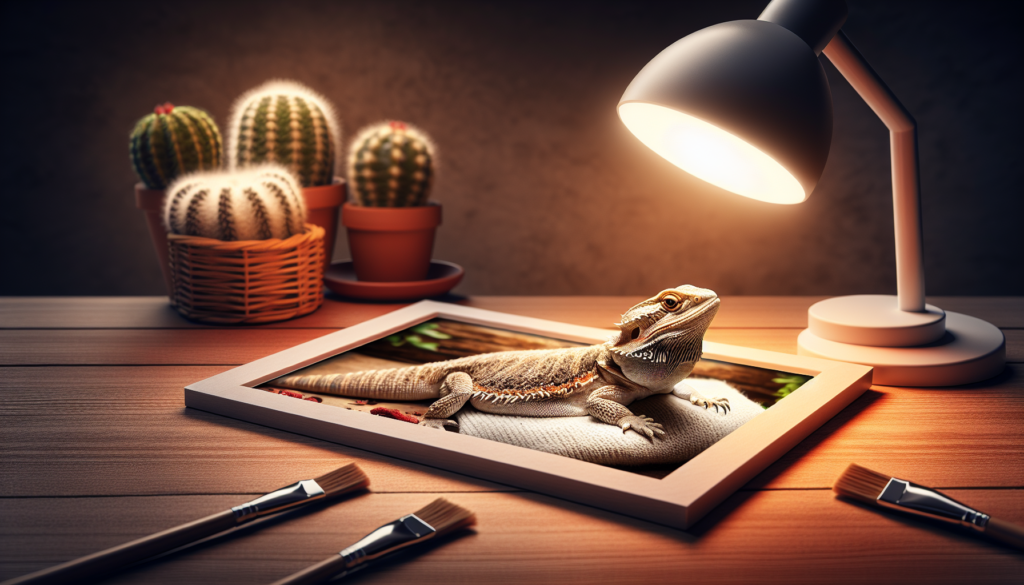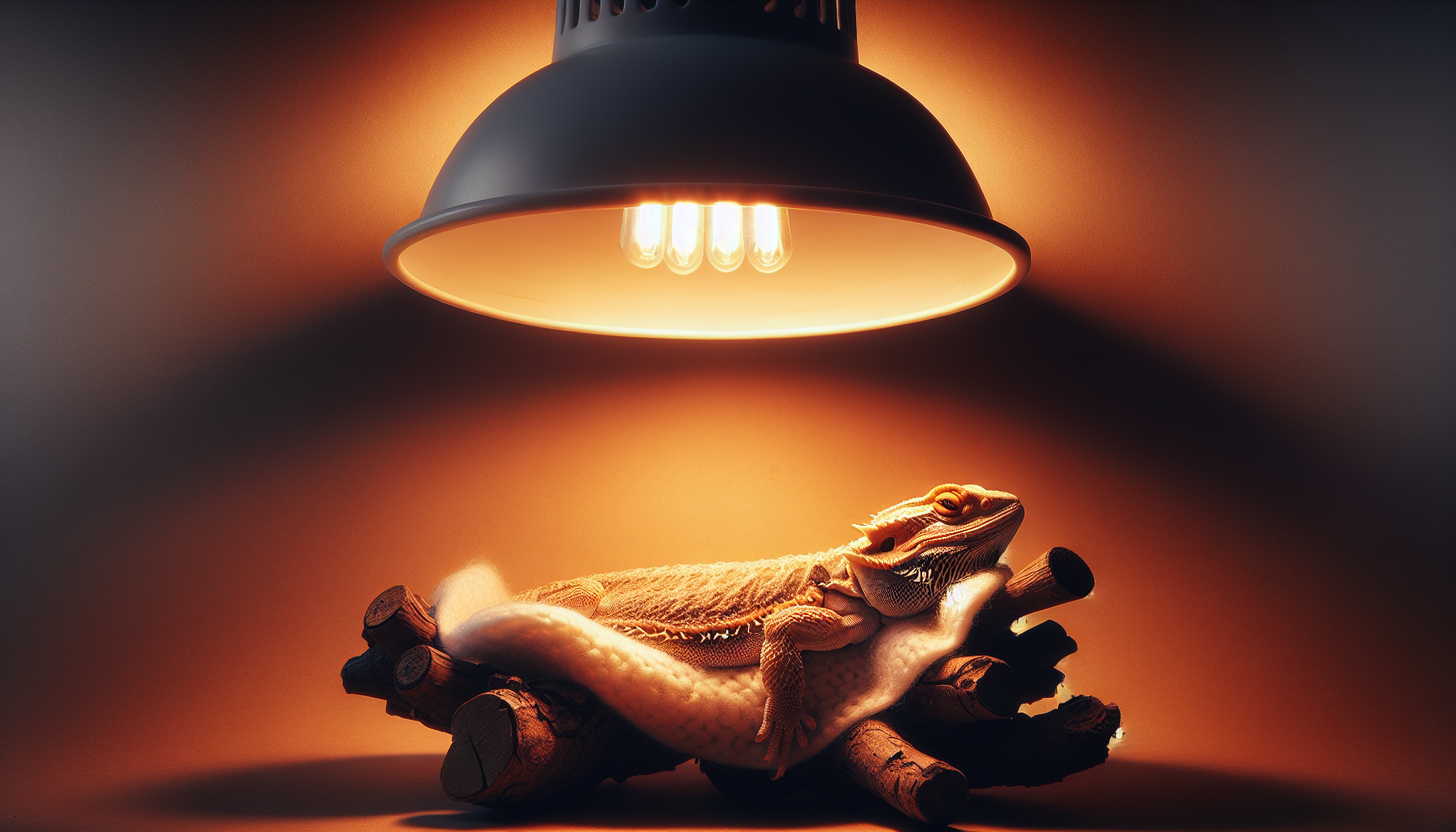Imagine having a pet that requires a cozy and warm environment to thrive in. Well, for all you bearded dragon enthusiasts out there, we have just the thing for you – the bearded dragon heat lamp. Designed specifically to meet the heat and lighting needs of these reptilian companions, this handy device creates the perfect habitat for your scaly friend. From regulating temperature to promoting their overall well-being, the Bearded Dragon Heat Lamp is an essential accessory that will ensure your pet’s comfort and happiness. Discover how this specialized heat lamp can transform your bearded dragon’s habitat into a warm and inviting haven, allowing them to bask in the ideal conditions for their ultimate health and happiness.
Benefits of Using a Bearded Dragon Heat Lamp

Maintains Optimal Temperature
Using a bearded dragon heat lamp is essential for maintaining the optimal temperature in your pet’s enclosure. Bearded dragons are ectothermic reptiles, which means they rely on external sources of heat to regulate their body temperature. A heat lamp provides a consistent and controlled heat source, allowing your bearded dragon to stay warm and comfortable.
Simulates Natural Environment
In the wild, bearded dragons bask in the sun to absorb heat and regulate their body temperature. A bearded dragon heat lamp helps simulate this natural environment by providing a similar source of heat and light. This is crucial for your pet’s overall well-being and ensures they can exhibit natural behaviors.
Promotes Digestion and Metabolism
A bearded dragon’s digestion and metabolism are highly dependent on external heat sources. By providing a heat lamp, you create a warm basking spot where your bearded dragon can raise its body temperature, promoting efficient digestion and metabolism. This helps prevent issues such as constipation and ensures your pet receives the necessary nutrients from its diet.
Helps Prevent Diseases
Maintaining the appropriate temperature through a heat lamp also contributes to your bearded dragon’s overall health and helps prevent diseases. Temperature fluctuations or inadequate warmth can weaken their immune system, making them susceptible to illnesses. With a heat lamp, you can create a stable and comfortable environment that supports their immune system and reduces the risk of health issues.
Choosing the Right Bearded Dragon Heat Lamp
Determining the Wattage
When selecting a bearded dragon heat lamp, it is crucial to consider the wattage. The wattage determines the intensity of the heat emitted by the lamp. The appropriate wattage depends on factors such as the size of your enclosure, the ambient temperature, and the distance between the lamp and the basking spot. It is recommended to consult with a reptile specialist or veterinarian to determine the suitable wattage for your specific setup.
Selecting the Bulb Type
There are different types of bulbs available for bearded dragon heat lamps, including ceramic and incandescent bulbs. Ceramic bulbs emit heat without producing light, making them ideal for providing heat during the night. On the other hand, incandescent bulbs emit both heat and light, mimicking the natural sunlight that bearded dragons need. Choose the bulb type based on your specific requirements and the needs of your bearded dragon.
Considering UVB Output
Apart from heat, bearded dragons also require UVB light for adequate vitamin D synthesis and calcium absorption. Some heat lamps are designed to provide both heat and UVB light, eliminating the need for separate lighting fixtures. If you opt for a heat lamp with UVB output, ensure that the lamp emits sufficient UVB rays to meet your bearded dragon’s needs. You may need to combine a heat lamp with a separate UVB bulb depending on the specific requirements of your pet.
Preference for Ceramic or Incandescent Bulbs
Depending on your bearded dragon’s natural habitat requirements, you may choose between ceramic or incandescent bulbs. Ceramic bulbs are useful for providing a consistent and controlled heat source without emitting any light. This is particularly beneficial for bearded dragons that require higher night-time temperatures. Incandescent bulbs, on the other hand, mimic the heat and light provided by the sun, creating a more natural and stimulating environment for your bearded dragon during the day.
Proper Placement of the Heat Lamp
Creating a Basking Spot
Proper placement of the heat lamp is crucial to create a suitable basking spot for your bearded dragon. The basking spot is an area within the enclosure where your pet can raise its body temperature and absorb heat. Position the heat lamp at one end of the enclosure and set it up at an angle to create a gradient of temperatures. This allows your bearded dragon to regulate its body temperature by moving closer or farther away from the lamp.
Ensuring Adequate Distance
It is essential to consider the distance between the heat lamp and the basking spot. Too close, and your bearded dragon may experience excessive heat, leading to dehydration or burns. Too far, and your pet may not receive enough heat to maintain the desired body temperature. The ideal distance can vary based on the wattage, enclosure size, and bulb type. Follow the manufacturer’s recommendations or consult with an expert to determine the appropriate distance for your specific setup.
Providing Multiple Temperature Zones
To cater to your bearded dragon’s varying temperature requirements, it is crucial to provide multiple temperature zones within the enclosure. The basking spot should offer the highest temperature range, allowing your pet to thermoregulate effectively. Gradually lower the temperature towards the cooler end of the enclosure, providing a thermal gradient that your bearded dragon can utilize to regulate its body temperature throughout the day.
Temperature Requirements for Bearded Dragons
Daytime Temperature
During the daytime, bearded dragons require a basking spot with a temperature range of 95°F to 105°F (35°C to 40°C). The cooler side of the enclosure should have temperatures ranging between 80°F to 90°F (27°C to 32°C). Maintaining these temperature ranges is vital for your bearded dragon’s overall health, digestion, and activity levels.
Nighttime Temperature
Bearded dragons require a drop in temperature during the night to mimic natural conditions. The nighttime temperature should range between 70°F to 75°F (21°C to 24°C). Ceramic bulbs are often used at night to provide a consistent heat source without disrupting your bearded dragon’s sleep cycle.
Temperature Gradient
Establishing a temperature gradient within the enclosure allows your bearded dragon to move between different heat zones to regulate its body temperature effectively. This gradient ensures your pet can thermoregulate as needed, mimicking the conditions they would experience in the wild.
Signs of Incorrect Temperature

Behavioral Changes
Incorrect temperature can significantly impact your bearded dragon’s behavior. If the enclosure is too hot, you may notice excessive lethargy, seeking cooler areas, or even aggression. If the temperature is too cold, your bearded dragon may become less active or exhibit signs of discomfort.
Loss of Appetite
Bearded dragons rely on external heat sources to aid digestion and metabolism. If the temperature is too low, it can lead to a loss of appetite. If your pet is not eating as usual, it may be an indication that the enclosure temperature needs adjustment.
Digestive Issues
Digestive issues such as constipation or diarrhea can be caused by incorrect temperatures. Both inadequate heat and excessive heat can disrupt your bearded dragon’s digestion, leading to discomfort and potential health problems. Monitoring the temperature and adjusting it accordingly can help prevent these issues.
Establishing a Heat Lamp Schedule
Maintaining the Day and Night Cycle
Bearded dragons, like many reptiles, rely on a natural day and night cycle to regulate their behavior and overall well-being. It is essential to establish a heat lamp schedule that aligns with this cycle. Mimic the natural sunlight patterns by providing 12-14 hours of light and heat during the day, followed by 10-12 hours of darkness at night. This helps maintain your bearded dragon’s natural rhythm and promotes a healthy sleep-wake cycle.
Adjusting for Seasonal Temperature Changes
Seasonal changes can affect the ambient temperature and overall heating requirements of your bearded dragon’s enclosure. As the external temperature fluctuates, it may be necessary to adjust the heat lamp settings or wattage to ensure your pet remains in a comfortable and healthy environment. Regularly monitor the temperature and make necessary adjustments based on the needs of your bearded dragon.
Maintenance and Safety Tips for Bearded Dragon Heat Lamps
Regularly Check Bulbs and Equipment
Regularly inspecting the heat lamp bulb and other associated equipment is essential for ensuring its proper functioning and safety. Check for any signs of wear, damage, or malfunction. If you notice any issues, replace the bulb or equipment promptly to prevent any potential hazards.
Clean the Bulb and Lamp Fixture
Dust and debris can accumulate on the surface of the bulb and lamp fixture, reducing its efficiency and posing a fire hazard. Regularly clean the bulb and lamp fixture using a soft cloth or brush to remove any buildup. Ensure the lamp is turned off and cool before cleaning, and follow the manufacturer’s guidelines for specific cleaning instructions.
Avoid Overheating or Underheating
Maintaining the correct temperature range is crucial for your bearded dragon’s health and safety. Regularly monitor the temperature within the enclosure using a reliable thermometer. Avoid overcompensating by increasing the heat lamp’s wattage too much, as this can lead to overheating. Similarly, ensure that the temperature does not drop too low, as it can compromise your pet’s well-being.
Prevent Electrical Hazards
When setting up the heat lamp, ensure that all electrical cords and connections are secure and away from any water sources or flammable materials. Avoid overloading electrical outlets and use surge protectors for added safety. Regularly inspect the cords for any signs of damage and replace them if needed.
Frequently Asked Questions (FAQs)
What wattage is suitable for a bearded dragon heat lamp?
The suitable wattage for a bearded dragon heat lamp depends on various factors such as enclosure size, ambient temperature, and bulb type. It is recommended to consult with a reptile specialist or veterinarian to determine the appropriate wattage for your specific setup.
Can I use a regular light bulb instead of a specialized heat lamp?
No, it is not recommended to use a regular light bulb instead of a specialized heat lamp. Regular light bulbs do not emit the necessary heat and light combination that bearded dragons require for their well-being. Specialized heat lamps are designed to provide the specific balance of heat and UVB output that your pet needs.
Do bearded dragons need both heat and UVB light?
Yes, bearded dragons require both heat and UVB light for their overall health. Heat helps regulate their body temperature, digestion, and metabolism, while UVB light is crucial for vitamin D synthesis and calcium absorption. Some heat lamps are designed to provide both heat and UVB output, eliminating the need for separate lighting fixtures.
How often should I replace the heat lamp bulb?
Heat lamp bulbs should be replaced every 6-12 months, even if they are still functioning. Over time, the output of heat and UVB can diminish, which may impact the well-being of your bearded dragon. Regularly replacing the bulb ensures that your pet receives the necessary heat and UVB rays.
